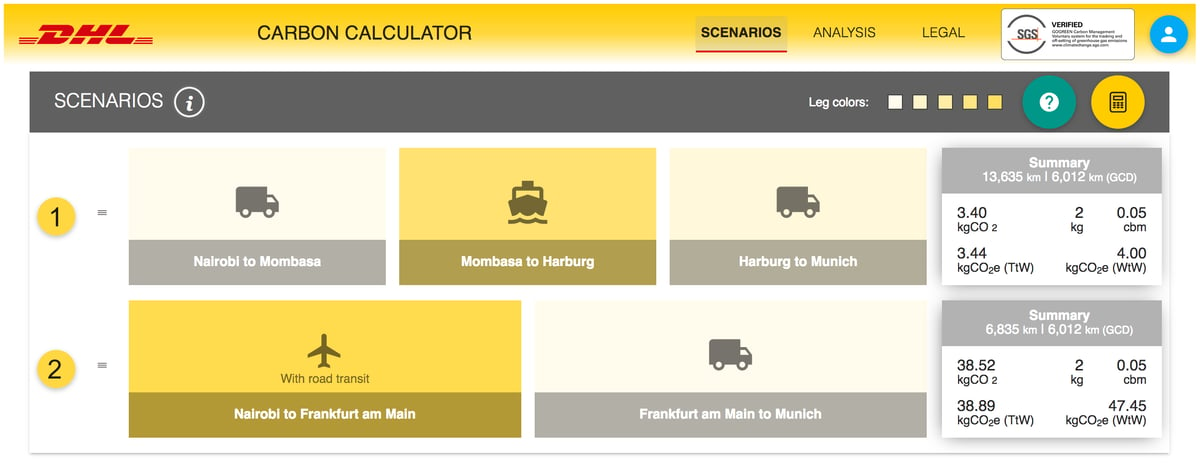Sometimes customers ask us whether it is possible to order handicraft products in Africa with a clear conscience in view of climate change? They wonder whether it would not be better to have their items made by the local craftsman considering the CO2 effect of an order. For this reason, we did some calculations.
 The aim of the Urban Change Lab is to make the world more beautiful and sustainable. In other words, to improve ecologically, socially and economically. With regard to the positive social and economic effects of the idea platform, we were relatively certain from the outset that we were doing the right thing. Among the ecological effects it was rather a gut feeling. We felt that the ecological effect was justifiable compared to the social advantages of the concept.
The aim of the Urban Change Lab is to make the world more beautiful and sustainable. In other words, to improve ecologically, socially and economically. With regard to the positive social and economic effects of the idea platform, we were relatively certain from the outset that we were doing the right thing. Among the ecological effects it was rather a gut feeling. We felt that the ecological effect was justifiable compared to the social advantages of the concept.
Now inspired by a few questions from critical customers, we wanted to know a little more precisely and have done some calculations with the support of external experts:
The CO2 effect of an order in Kenya
When a customer uses us to have his idea produced by a craftsman in Africa, this always leads to a flow of goods, e.g. from Nairobi to Munich. For this purpose, energy is used for transport, which leads to CO2 emissions. The question is, how much CO2 is emitted to transport this order. And above all, how does this relate to other forms of consumption. Since we are concerned here with a comparison between production in Africa and local production, we only consider the transport of the finished product from the craftsman to the customer. We deliberately leave out the transport of raw materials to the craftsman, as we assume that raw materials such as leather, wood and fabric are available and used locally. The craftsman in Kenya may even have an advantage here.
An average order at the Urban Change Lab weighs approx. 1 kg (e.g. bag) to 2 kg (e.g. cutlery box) and is shipped in a package with a volume of 0.015m³ to 0.05m³. There are two ways of shipping: by sea (e.g. Nairobi to Mombasa by truck or train, Mombasa to Hamburg by ship, Hamburg to Munich by truck or train) or by air freight (Nairobi to Frankfurt by air freight, Frankfurt to Munich by truck or train). We prefer the sea route in the long term, as we focus on decelerated consumption and in this respect the delivery time is generally not decisive for our customers. For CO2 emissions, however, it is very important whether air or sea freight is used. The routes we use show that air freight causes approximately 10 times higher CO2 emissions.
By the way, we tried different CO2 calculation tools to be sure that we are also calculating with realistic values. It turned out that the results of the different tools available in the internet are relatively close together. We calculated finally with the CO2 calculator from DHL and had the result confirmed by external experts. In our calculations we have always used the truck and not the train within Germany, as trucks are usually used for our product class. In addition, the last mile (i.e. to the front door) was also taken into account in the tool.
Example calculation for a bag from Nairobi to Munich (1 kg)
Example calculation for a cutlery tray (2kg) from Nairobi to Munich

As you can see, the CO2 effect of an order and transport of a bag by sea from Nairobi to Munich produces approx. 1kg of the greenhouse gas CO2, the cutlery box approx. 3.4kg.
This is slightly above the level of transport of a comparable product from Asia. Or is produced during the production of 100 grams or 340 grams of beef.
How big is the CO2 effect of an order for the logistics of comparable products from local production
Before we start calculating: Basically, we think it is a very good idea to promote local crafts all over the world, including Germany. Craftsmanship is art and tradition and individual pieces or small series produced by a craftsman are something very special. Our goal is to replace fast moving, industrial disposable products with lovingly manufactured, long-lasting handicraft products. This results in a positive ecological balance, regardless of the place of manufacture.
In local production, the individual circumstances under which the craftsman works with the customer have a significant influence on CO2 emissions. Whoever has his craftsman within walking distance, or within reach by bicycle, naturally causes a CO2-Emission which is hardly measurable (one would breathe either way). The situation is completely different when you drive in your car to a craftsman to have something made. Then the question arises, how far do you get in order to emit 1kg CO2 (bag) or 3.4kg (cutlery box):
Consider an average car with 8 litres of fuel consumption per 100 km, this car burns approx. 185g CO2 per km (if your car consumes less you can then calculate down in the ratio). This means that for a bag production (1kg CO2 for the transport from Nairobi to Munich to the front door, means 1,000g) 5.4km could be driven. If you only go to pick it up at your local craftsman, he should be 2.7km away. If you want to meet with the local craftsman in advance to order, then 1.3km distance to the craftsman would be comparable to a transport from Kenya with a logistic company.
For the cutlery box there is 3.4 kg CO2 for the transport of the 2kg package from Kenya. This corresponds to about 18 km by car. So about 4,5 km distance to the local carpenter (once to order, once to pick up). If these numbers surprise you: If you travel by car and transport 2kg, you move more than 1,000 kg net weight of the car compared to the 2kg transported weight of less than 2kg net weight of a truck. As a result, the truck can be more than 500 times more efficient than your own car. Things are even better for transport on the boat.
As I said, it always depends how big the ultimative CO2 effect of an order is and how this compare to an alternative product or sulution. But we hope to have helped you with our explanations in deciding whether you can take responsibility for an order in Africa.
In any case, this calculation has strengthened our assessment that we can expand our business with a clear conscience. For the sake of completeness, we are currently still transporting by air freight. This is primarily due to the low number of orders currently, which do not yet permit large-scale consolidation. With your help however, we can soon switch to ocean freight.
To make it even easier for you to decide if you want to try us out, we have conducted CO2-Compensation for all previous orders by supporting CO2 reducing projects and we will also do this for all future orders. So even die-hard cyclists can order from us with a clear conscience. Let’s make the world more beautiful together!


Leave a Reply